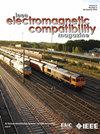Design of Planar Magnetic Integrated Symmetrical Harmonic Filter With Reduced EMI Noise in the Grid-Connected Inverter
IF 2.5
3区 计算机科学
Q3 ENGINEERING, ELECTRICAL & ELECTRONIC
IEEE Transactions on Electromagnetic Compatibility
Pub Date : 2025-04-08
DOI:10.1109/TEMC.2025.3554784
引用次数: 0
Abstract
The inverter is an essential power conversion device in the power generation system, but the output current by the inverter system contains a large number of harmonics, and harmonic filters need to be used for harmonic suppression to meet grid connection standards. As a third-order filter, the设计可降低并网逆变器 EMI 噪声的平面磁性集成对称谐波滤波器
逆变器是发电系统中必不可少的功率转换装置,但逆变器系统输出的电流中含有大量谐波,需要使用谐波滤波器进行谐波抑制,以满足并网标准。LCL滤波器作为一种三阶滤波器,具有较高的噪声衰减率,应用广泛。然而,LCL滤波器在抑制电磁干扰(EMI)噪声方面并不理想。对称LCL滤波器在保证谐波抑制能力的同时,提高了对EMI噪声的抑制效果。然而,与LCL滤波器相比,对称LCL滤波器增加了两个电感,导致逆变器系统的体积和重量显著增加。本文对对称LCL滤波器的结构进行了分析,提出了耦合集成和解耦集成的解决方案,采用平面磁集成的方法,通过合理设计绕组结构,将对称LCL滤波器的电感集成到同一个EI磁芯中,大大减小了滤波器的尺寸和重量。最后,通过仿真和基于gan的实验平台,验证了所设计的磁集成对称LCL滤波器的谐波抑制效果和EMI抑制效果。
本文章由计算机程序翻译,如有差异,请以英文原文为准。
求助全文
约1分钟内获得全文
求助全文
来源期刊
CiteScore
4.80
自引率
19.00%
发文量
235
审稿时长
2.3 months
期刊介绍:
IEEE Transactions on Electromagnetic Compatibility publishes original and significant contributions related to all disciplines of electromagnetic compatibility (EMC) and relevant methods to predict, assess and prevent electromagnetic interference (EMI) and increase device/product immunity. The scope of the publication includes, but is not limited to Electromagnetic Environments; Interference Control; EMC and EMI Modeling; High Power Electromagnetics; EMC Standards, Methods of EMC Measurements; Computational Electromagnetics and Signal and Power Integrity, as applied or directly related to Electromagnetic Compatibility problems; Transmission Lines; Electrostatic Discharge and Lightning Effects; EMC in Wireless and Optical Technologies; EMC in Printed Circuit Board and System Design.

 求助内容:
求助内容: 应助结果提醒方式:
应助结果提醒方式:


